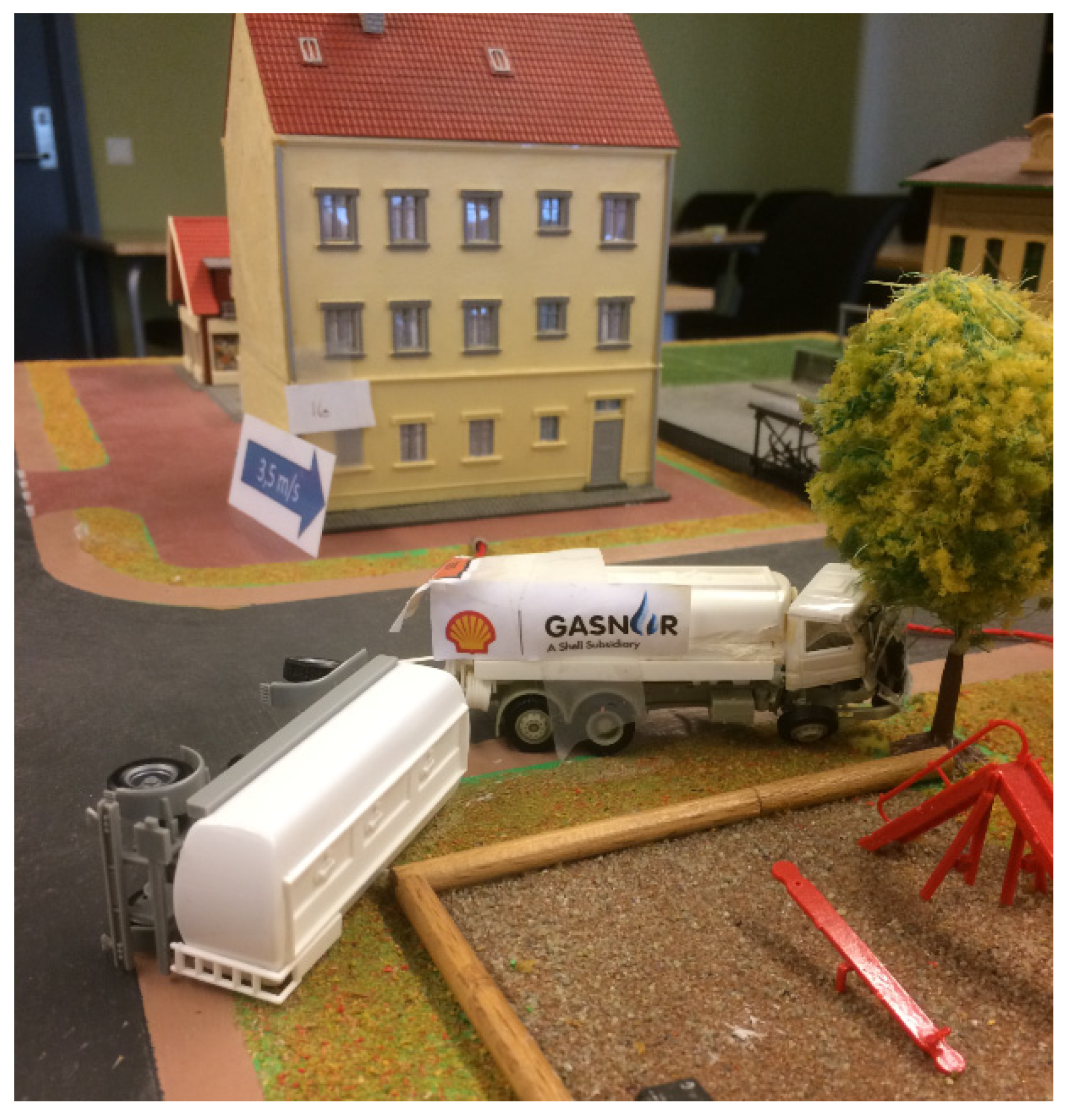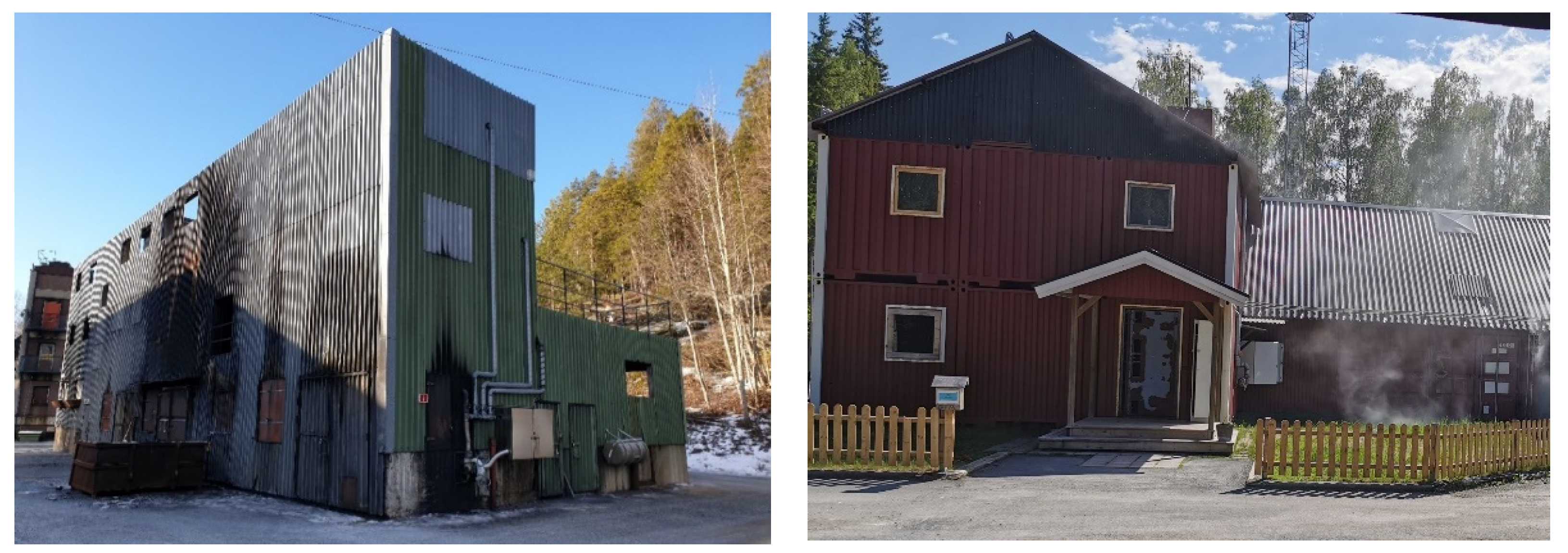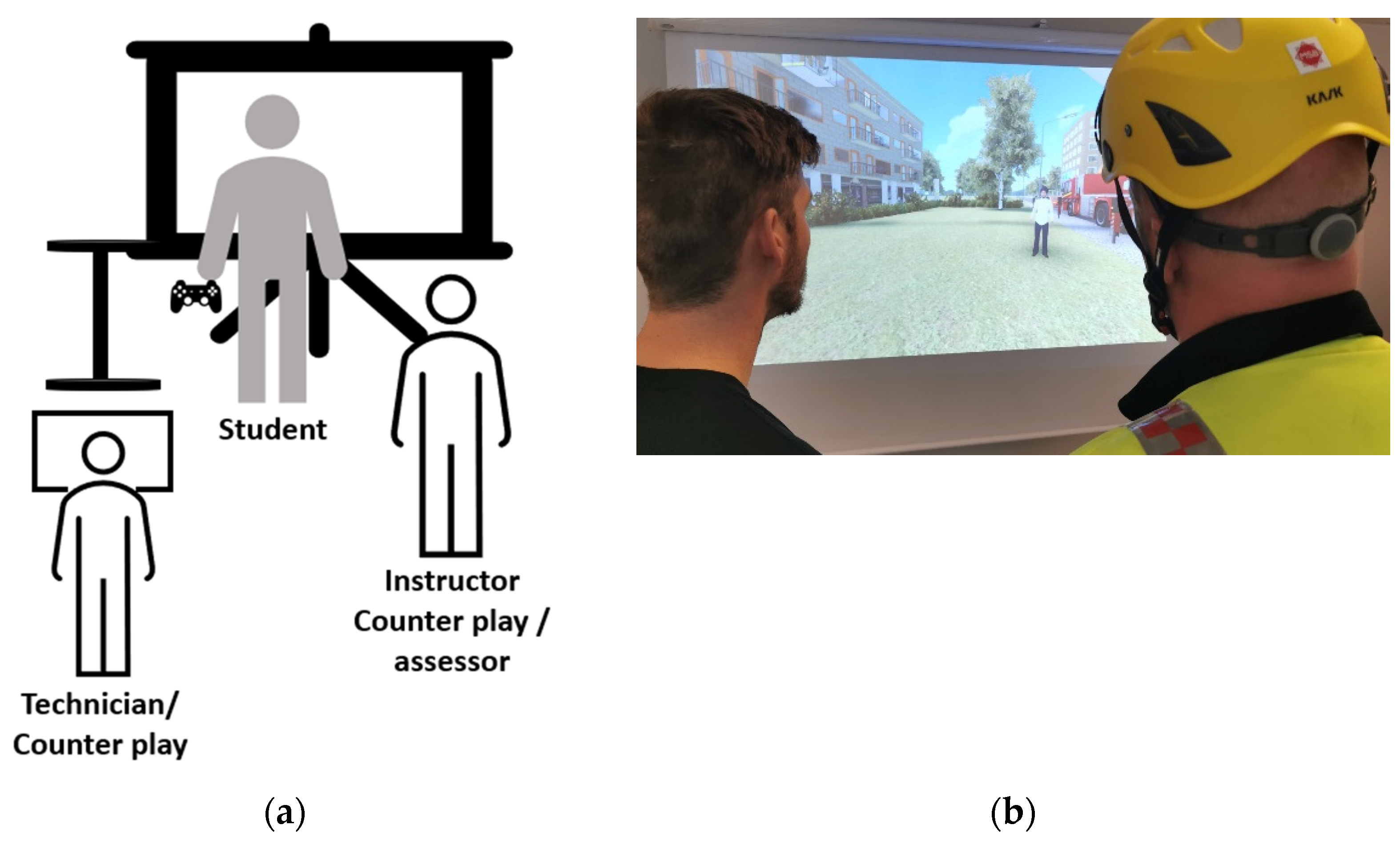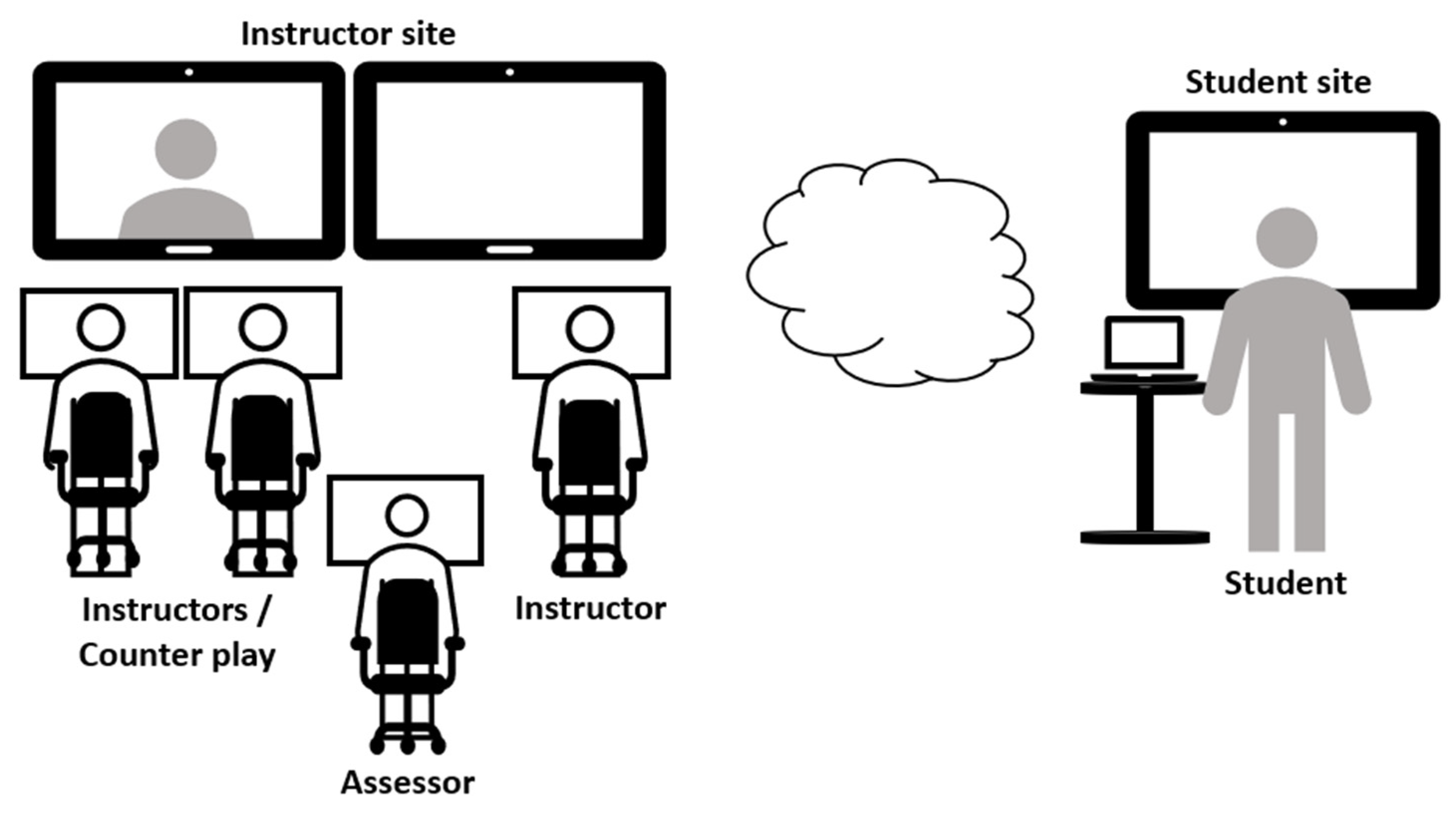Remote Virtual Simulation for Incident Commanders—Cognitive Aspects
Abstract
:1. Introduction
2. Theoretical Background
2.1. Cognitive Science
2.2. Simulation Training
2.3. Learning Approach
3. Method
4. Learning Spaces
4.1. Classroom Setting (CS)
4.2. Live Simulation (LS)
4.3. Virtual Simulation (VS)
5. Enablers for RVS Examination
5.1. Experiences of VS Training On-Site at MSB before the COVID-19 Pandemic
5.2. The Pilot Test, before Deciding upon Remote Virtual Simulation Examination
6. Results: RVS Examination
6.1. The RVS Examination—The Students’ Experiences
6.2. The RVS Examination—The Instructors’ Experiences
6.3. Cognitive Aspects in Simulation Training
7. Discussion
- The technology had previously been used for VS training on-site. Thereby, existing technical, scenario design, and conduction competence saved time and guaranteed usability.
- It was possible to perform a pilot test with experienced ICs. The positive evaluation motivated the final decision to use the RVS examination.
- A key component was the competence and interest of one champion and support from experienced VS instructors who were assigned time to participate.
8. Conclusions
Author Contributions
Funding
Institutional Review Board Statement
Informed Consent Statement
Data Availability Statement
Acknowledgments
Conflicts of Interest
References
- Lamb, J.K.; Davies, J.; Bowley, R.; Williams, J.P. Incident command training: The introspect model. Int. J. Emerg. Serv. 2014, 3, 131–143. [Google Scholar] [CrossRef]
- Bjølseth, T. Grunnkurs for Brannkonstabel, Hefte 1, 3rd ed.; Norsk Brannvernforening: Oslo, Norway, 2019; p. 18. ISBN 978-82-7485-099-4. [Google Scholar]
- MSB. Available online: www.msb.se/sv/utbildning--ovning/alla-utbildningar/ (accessed on 10 April 2021).
- Flin, R.; O’Connor, P.; Crichton, M. Safety at the Sharp End; A Guide to Non-Technical Skills, 4th ed.; Ashgate: Farnham, UK, 2015; p. 307. ISBN 978-0754646006. [Google Scholar]
- Williams-Bell, F.M.; Murphy, B.M.; Kapralos, B.; Hogue, A.; Weckman, E.J. Using serious games and virtual simulation for training in the fire service: A review. Fire Technol. 2015, 51, 553–584. [Google Scholar] [CrossRef]
- Fowler, C. Virtual reality and learning: Where is the pedagogy? Br. J. Educ. Technol. 2015, 46, 412–422. [Google Scholar] [CrossRef]
- Koutromanos, G.; Sofos, A.; Avramidou, L. The use of augmented reality games in education: A review of literature. Educ. Media Int. 2015, 52, 235–271. [Google Scholar] [CrossRef]
- Crandall, B.; Klein, G.; Klein, G.A.; Hoffman, R.R.; Hoffman, R.R. Working Minds: A Practitioner’s Guide to Cognitive Task Analysis; MIT Press: Cambridge, MA, USA, 2006; ISBN 13: 978-0262532815. [Google Scholar]
- Braa, K.; Vidgen, R.T. Interpretation, intervention, and reduction in the organizational laboratory: A framework for in-context information systems research. Inf. Organ. 1999, 9, 25–47. [Google Scholar] [CrossRef]
- Friedenberg, J.; Silverman, G. Cognitive Science: An Introduction to the Study of the Mind, 3rd ed.; Sage Publications: Thousand Oaks, CA, USA, 2015; ISBN 978-1483347417. [Google Scholar]
- Norman, D.A. Twelve issues for cognitive science. Cogn. Sci. 1980, 4, 1–32. [Google Scholar] [CrossRef]
- Wang, Y.; Wang, Y.; Patel, S.; Patel, D. A layered reference model of the brain. IEEE Trans. Syst. Man Cybern. Part C Appl. Rev. 2006, 36, 124–133. [Google Scholar] [CrossRef]
- de Groot, A.D. Thought and Choice in Chess; Mouton Publishers: The Hague, The Netherlands, 1965. [Google Scholar] [CrossRef]
- Bransford, J.D.; Brown, A.L.; Cocking, R.R. (Eds.) How People Learn: Brain, Mind, Experience, and School; National Academy Press: Washington, DC, USA, 2000. [Google Scholar] [CrossRef]
- Wilson, R.A.; Keil, F.C. (Eds.) The MIT Encyclopedia of the Cognitive Sciences; The MIT Press: Cambridge, MA, USA, 1999. [Google Scholar]
- Bobrow, D.G.; Norman, D.A. Some principles of memory schemata. In Representation and Understanding: Studies in Cognitive Science; Bobrow, D.G., Collins, A.M., Eds.; Academic Press: New York, NY, USA, 1975. [Google Scholar]
- Thornton, M.; Mosher, G. Quantifying cognitive processes in virtual learning simulations. In Proceedings of the 2014 ASEE North Midwest Section Conference, Iowa City, IA, USA, 16–17 October 2014. [Google Scholar]
- Endsley, M.R. Design and evaluation for situation awareness enhancement. In Proceedings of the Human Factors and Ergonomics Society Annual Meeting, Anaheim, CA, USA, 1 October 1988; pp. 97–101. [Google Scholar] [CrossRef]
- Endsley, M.R. Toward a theory of situation awareness in dynamic systems. Hum. Factors 1995, 37, 32–64. [Google Scholar] [CrossRef]
- Endsley, M.R. Expertise and situation awareness. In The Cambridge Handbook of Expertise and Expert Performance; Ericsson, K.A., Charness, N., Feltovich, P.J., Hoffman, R.R., Eds.; Cambridge University Press: New York, NY, USA, 2006; pp. 633–651. [Google Scholar]
- Klein, G. A recognition primed decision (RPD) model of rapid decision making. In Decision Making in Action; Klein, G., Orasanu, J., Calderwood, R., Zsambok, C., Eds.; Ablex: Norwood, NJ, USA, 1993; pp. 138–147. [Google Scholar]
- Klein, G. Streetlights and Shadows: Searching for the Keys to Adaptive Decision Making; MIT Press: Cambridge, MA, USA, 2009. [Google Scholar]
- Cohen-Hatton, S.R.; Butler, P.C.; Honey, R.C. An Investigation of operational decision making in situ: Incident command in the U.K. fire and rescue service. Hum. Factors 2015, 57, 793–804. [Google Scholar] [CrossRef] [PubMed]
- Rake, E.L.; Njå, O. Perceptions and performances of experiences incident commanders. J. Risk Res. 2009, 12, 665–685. [Google Scholar] [CrossRef]
- Good, M. Patient simulation for training basic and advanced clinical skills. Med Educ. 2003, 37, 14–21. [Google Scholar] [CrossRef] [PubMed]
- Samei, E.; Kinahan, P.; Nishikawa, R.M.; Maidment, A. Virtual clinical trials: Why and what (special section guest editorial). J. Med. Imaging 2020, 42801. [Google Scholar] [CrossRef]
- Archer, F.; Wyatt, A.; Fallows, B. Use of simulators in teaching and learning: Paramedics’ evaluation of a patient simulator. Australas. J. Paramed. 2007, 5. [Google Scholar] [CrossRef] [Green Version]
- Gallagher, A.G.; Ritter, E.M.; Champion, H.; Higgins, G.; Fries, M.P.; Moses, G.; Smith, C.D.; Satava, R.M. Virtual reality simulation for the operating room. Ann. Surg. 2005, 241, 364–372. [Google Scholar] [CrossRef]
- Robinson, S.; Radnor, Z.J.; Burgess, N.; Worthington, C. SimLean: Utilising simulation in the implementation of lean in healthcare. Eur. J. Oper. Res. 2012, 219, 188–197. [Google Scholar] [CrossRef] [Green Version]
- Cohen, D.; Sevdalis, N.; Taylor, D.; Kerr, K.; Heys, M.; Willett, K.; Batrick, M.; Darzi, A. Emergency preparedness in the 21st century: Training and preparation modules in virtual environments. Resuscitation 2013, 84, 78–84. [Google Scholar] [CrossRef] [PubMed]
- Alfes, C.M.; Reimer, A. Joint training simulation exercises: Missed elements in prehospital patient handoffs. Clin. Simul. Nurs. 2016, 12, 215–218. [Google Scholar] [CrossRef]
- Ahern, M.M.; Dean, L.V.; Stoddard, C.C.; Agrawal, A.; Kim, K.; Cook, C.E.; Narciso Garcia, A. The effectiveness of virtual reality in patients with spinal pain: A systematic review and meta-analysis. Pain Pract. 2020, 20, 656–675. [Google Scholar] [CrossRef]
- Riva, G. Virtual reality in psychotherapy. Cyberpsychology Behav. 2005, 8, 220–230. [Google Scholar] [CrossRef] [Green Version]
- Rudolph, J.W.; Simon, R.; Raemer, D.B. Which reality matters? Questions on the path to high engagement in healthcare simulation. Simul. Healthc. 2007, 2. [Google Scholar] [CrossRef] [Green Version]
- Engström, H.; Hagiwara, M.A.; Backlund, P.; Lebram, M.; Lundberg, L.; Johannesson, M.; Sterner, A.; Söderholm, H.M. The impact of contextualization on immersion in healthcare simulation. Adv. Simul. 2016, 1, 1–11. [Google Scholar] [CrossRef] [Green Version]
- Aebersold, M. Simulation-based learning: No longer novelty in undergraduate education. OJIN Online J. Issues Nurs. 2018, 23, 1–13. [Google Scholar] [CrossRef]
- Parong, J.; Mayer, R.E. Cognitive and affective processes for learning science in immersive virtual reality. J. Comput. Assist. Learn. 2021, 37, 226–241. [Google Scholar] [CrossRef]
- Kara, N. A systematic review of the use of serious games in science education. Contemp. Educ. Technol. 2021, 13, ep295. [Google Scholar] [CrossRef]
- Bonde, M.T.; Makransky, G.; Wandall, J.; Larsen, M.V.; Morsing, M.; Jarmer, H.; Sommer, M.O. Improving biotech education through gamified laboratory simulations. Nat. Biotechnol. 2014, 32, 694–697. [Google Scholar] [CrossRef] [PubMed] [Green Version]
- Livingstone, D.; Kemp, J.; Edgar, E. From multi-user virtual environment to 3D virtual learning environment. ALT-J 2008, 16, 139–150. [Google Scholar] [CrossRef]
- Horváth, I.; Sudár, A. Factors contributing to the enhanced performance of the maxwhere 3d vr platform in the distribution of digital information. Acta Polytech. Hung. 2018, 15, 149–173. [Google Scholar] [CrossRef]
- Harada, Y.; Ohyama, J. The effect of task-irrelevant spatial contexts on 360-degree attention. PLoS ONE 2020, 15, e0237717. [Google Scholar] [CrossRef] [PubMed]
- Howett, D.; Castegnaro, A.; Krzywicka, K.; Hagman, J.; Marchment, D.; Henson, R.; Rio, M.; King, J.A.; Burgess, N.; Chan, D. Differentiation of mild cognitive impairment using an entorhinal cortex-based test of virtual reality navigation. Brain 2019, 142, 1751–1766. [Google Scholar] [CrossRef] [PubMed] [Green Version]
- Santos, B.S.; Dias, P.; Pimentel, A.; Baggerman, J.-W.; Ferreira, C.; Silva, S.; Madeira, J. Head-mounted display versus desktop for 3D navigation in virtual reality: A user study. Multimed. Tools Appl. 2009, 41, 161–181. [Google Scholar] [CrossRef] [Green Version]
- Niehorster, D.C.; Li, L.; Lappe, M. The accuracy and precision of position and orientation tracking in the HTC vive virtual reality system for scientific research. i-Perception 2017, 8. [Google Scholar] [CrossRef] [Green Version]
- Paiva, A.; Leite, I.; Boukricha, H.; Wachsmuth, I. Empathy in virtual agents and robots: A survey. ACM Trans. Interact. Intell. Syst. TiiS 2017, 7, 1–40. [Google Scholar] [CrossRef]
- Costescu, C.; Rosan, A.; Hathazi, A.; Pădure, M.; Brigitta, N.; Kovari, A.; Katona, J.; Thill, S.; Heldal, I. Educational tool for testing emotion recognition abilities in adolescents. Acta Polytech. Hung. 2020, 17. [Google Scholar] [CrossRef]
- Schroeder, R.; Steed, A.; Axelsson, A.-S.; Heldal, I.; Abelin, Å.; Wideström, J.; Nilsson, A.; Slater, M. Collaborating in networked immersive spaces: As good as being there together? Comput. Graph. 2001, 25, 781–788. [Google Scholar] [CrossRef]
- Makransky, G.; Andreasen, N.K.; Baceviciute, S.; Mayer, R.E. Immersive virtual reality increases liking but not learning with a science simulation and generative learning strategies promote learning in immersive virtual reality. J. Educ. Psychol. 2020, 113, 719–735. [Google Scholar] [CrossRef]
- Radianti, J.; Majchrzak, T.A.; Fromm, J.; Wohlgenannt, I. A systematic review of immersive virtual reality applications for higher education: Design elements, lessons learned and research agenda. Comput. Educ. 2020, 147, 103778. [Google Scholar] [CrossRef]
- Alexander, A.L.; Brunyé, T.; Sidman, J.; Weil, S.A. From Gaming to Training: A Review of Studies on Fidelity, Immersion, Presence, and Buy-In and Their Effects on Transfer in PC-Based Simulations and Games; DARWARS Training Impact Group: Woburn, UK, 2005; Volume 5, pp. 1–14. [Google Scholar]
- Engelbrecht, H.; Lindeman, R.W.; Hoermann, S. A SWOT analysis of the field of virtual reality for firefighter training. Front. Robot. AI 2019, 6, 101. [Google Scholar] [CrossRef] [Green Version]
- Heldal, I.; Wijkmark, C.H. The RoI of simulation-based training vs live training of incident commanders. In Proceedings of the ITEC, Stockholm, Sweden, 14–16 May 2019. [Google Scholar]
- Swedish Civil Protection Act and Regulation: Lag (2003:778) om Skydd mot Olyckor, Latest Update 2020:882, Förordning (2003:789). Available online: https://www.riksdagen.se/sv/dokument-lagar/dokument/svensk-forfattningssamling/lag-2003778-om-skydd-mot-olyckor_sfs-2003-778 (accessed on 15 April 2021).
- Bloom, B.S. Taxonomy of Educational Objectives, Handbook I: The Cognitive Domain; David McKay Co Inc.: New York, NY, USA, 1956. [Google Scholar]
- Mattsson, M.; Eriksson, L. Taktikkboken—En Håndbok i Systematisk Ledelse av Slokkeinnsatser mot Bygningsbranner (The Book of Tactics—A Handbook for Systematic Management of Firefighting Efforts Against Building Fires); Norsk Brannvernforening: Oslo, Norway, 2017; ISBN 978-82-7485-093-4. [Google Scholar]
- Curriculum Incident Commander Level 1. The Swedish Civil Contingencies Agency, 2018. Available online: https://www.msb.se/siteassets/dokument/utbildning-och-ovning/alla-utbildningar/2018-00019-kursplan-raddningsledare-a.pdf (accessed on 16 April 2021).
- Hammar-Wijkmark, C.; Heldal, I. Virtual and live simulation-based training for incident commanders. In Proceedings of the ISCRAM, Information Systems for Crisis Response and Management, Blacksburg, VA, USA, 24–27 May 2020; pp. 1154–1162. [Google Scholar]
- Grant, C.C. Firefighter Safety and Emergency Response for Electric Drive and Hybrid Electric Vehicles; Fire Protection Research Foundation: Quincy, MA, USA, 2010; pp. 1–135. [Google Scholar]
- Metallinou, M.M. Liquefied natural gas as a new hazard, learning processes in Norwegian fire brigades. Safety 2019, 5, 11. [Google Scholar] [CrossRef] [Green Version]
- Baskerville, R.; Wood-Harper, A.T. A critical perspective on action research as a method of information systems research. J. Inf. Technol. 1996, 11, 235–246. [Google Scholar] [CrossRef]
- Yin, R.K. Case Study Research: Design and Methods, 3rd ed.; Sage Publications: London, UK, 2003; ISBN 0-7619-2553-8. [Google Scholar]
- Reis, V.; Neves, C. Application of virtual reality simulation in firefighter training for the development of decision-making competences. In Proceedings of the International Symposium on Computers in Education (SIIE), Tomar, Portugal, 21–23 November 2019; IEEE: Piscataway, NJ, USA, January 2020. [Google Scholar] [CrossRef]
- Heldal, I. Contextual support for emergency management training: Challenges for simulation and serious games. In Proceedings of the 10th International and Interdisciplinary Conference, CONTEXT 2017, Paris, France, 20–23 June 2017; Brézillon, P., Turner, R., Pencopp, C., Eds.; Springer: Berlin/Heidelberg, Germany, 2017; pp. 484–497. [Google Scholar] [CrossRef]
- Polykarpus, S.; Ley, T.; Poom-Valickis, K. Collaborative authoring of virtual simulation scenarios for assessing situational awareness. In Proceedings of the 18th ISCRAM Conference, Blacksburg, VA, USA, 23–26 May 2021. [Google Scholar]
- Hammar-Wijkmark, C.; Metallinou, M.M.; Heldal, I.; Fankvist, S. The role of virtual simulation in incident commander education—A field study. NIK Norsk Informatikkonferanse 2020, 1, 1–12. [Google Scholar]
- Lamb, K.; Boosman, M.; Davies, J. Introspect model: Competency assessment in the virtual world. In Proceedings of the ISCRAM, Kristiansand, Norway, 24–27 May 2015. [Google Scholar]
- Heldal, I. The Usability of Collaborative Virtual Environments: Towards an Evaluation Framework. Ph.D. Thesis, Department of Technology and Society, Chalmers University of Technology, Göteborg, Sweden, 2004. [Google Scholar]
- Sommer, M.; Braut, G.S.; Njå, O. A model for learning in emergency response work. Int. J. Emerg. Manag. 2013, 9, 151–169. [Google Scholar] [CrossRef]
- Kolb, D.A. Experiential Learning: Experience as the Source of Learning and Development; Prentice Hall: Englewood Cliffs, NJ, USA, 1984. [Google Scholar]
- Wijkmark, C.H.; Heldal, I.; Fankvist, S.; Metallinou, M.M. Remote virtual simulation for incident commanders: Opportunities and possibilities. In Proceedings of the 11th IEEE International Conference on Cognitive Infocommunications—CogInfoCom 2020, Online on MaxWhere 3D Web, 23–25 September 2020; 2020. [Google Scholar]
- Moskaliuk, J.; Bertram, J.; Cress, U. Impact of virtual training environments on the acquisition and transfer of knowledge. Cyberpsychol. Behav. Soc. Netw. 2013, 16, 210–214. [Google Scholar] [CrossRef]
- Bertram, J.; Moskaliuk, J.; Cress, U. Virtual training: Making reality work? Comput. Hum. Behav. 2015, 34, 284–292. [Google Scholar] [CrossRef]
- Ganier, F.; Hoareau, C.; Tisseau, J. Evaluation of procedural learning transfer from a virtual environment to a real situation: A case study on tank maintenance training. Ergonomics 2014, 57, 828–843. [Google Scholar] [CrossRef] [PubMed]
- Hall, K.A. The Effect of Computer-Based Simulation Training on Fire Ground Incident Commander Decision Making. Ph.D. Thesis, The University of Texas at Dallas, Dallas, TX, USA, May 2010. [Google Scholar]
- Gillespie, S. Fire Ground Decision-Making: Transferring Virtual Knowledge to the Physical Environment. Ph.D. Thesis, Grand Canyon University, Phoenix, AZ, USA, 29 July 2013. [Google Scholar]
- Wickström, G.; Bendix, T. The “Hawthorne effect”—What did the original Hawthorne studies actually show? Scand. J. Work. Environ. Health 2000, 26, 363–367. [Google Scholar] [CrossRef] [PubMed]
- Merrett, F. Reflections on the Hawthorne effect. Educ. Psychol. 2007, 26, 143–146. [Google Scholar] [CrossRef]






| Questions | % Answers Likert 4 or 5 | Average (Scale 1–5) | Standard Deviation |
|---|---|---|---|
| Experienced presence, compared to previous very high? | 72% | 3.90 | 0.83 |
| Experienced presence in the simulated environment? | 59% | 3.63 | 0.86 |
| Experienced being in the same env. as the “persons” you met? | 68% | 3.81 | 0.99 |
| How easy was it to understand the training objectives? | 80% | 4.16 | 0.73 |
| Would you like to perform similar training at your fire station? | 100% | 4.86 | 0.35 |
| Would you like to perform similar training in your spare time? | 80% | 4.28 | 0.95 |
| Nr | Scenario Description | Learning Points Observed and Assessed |
|---|---|---|
| S1 | Road traffic collision. A farmer has ended up in the ditch while attempting to avoid a collision with a deer. The farmer is not injured. On the pickup he has an IBC (Intermediate Bulk Container) with an unknown chemical. The tank faucet had been damaged and there was a leak. The chemical is Roundup, a herbicide that cannot be found in the decision support tool used by ICs in Sweden. | GENERAL LEARNING POINTS as presented in Figure 1. SPECIFIC FOR THIS SCNENARIO:
|
| S2 | A garage attached to a Villa is on fire. The fire has started in a pile of junk in the garage attached to a villa. The family is safe outside. | GENERAL LEARNING POINTS as in Figure 1. SPECIFIC FOR THIS SCENARIO
|
| S3 | A fire in an apartment on the third floor. It is uncertain if anyone is inside the apartment initially. After a while, the friend of the owner of the apartment approaches the IC and explains that the owner is abroad, but her cat is in the apartment. | GENERAL LEARNING POINTS as in Figure 1. SPECIFIC FOR THIS SCENARIO
|
| S4 | Road traffic collision including three vehicles under an overpass. The collision is caused by timber on the road, that have come loose from a timber truck. | GENERAL LEARNING POINTS as in Figure 1. SPECIFIC FOR THIS SCENARIO
|
| S5 | Fire in a warehouse. Some youngsters have broken into the warehouse and started two fires before they left. There are caravans and vehicles, welding gas, etc. inside. | GENERAL LEARNING POINTS as in Figure 1. SPECIFIC FOR THIS SCENARIO
|
| Student | Comment |
|---|---|
| S1 | I think it worked out well. Thanks to you [instructors], and it must be more of this in the course, especially remotely. It was gold [great], as close to real as it can get. And I did not have to drive 2000 km to the College [for the examination]. |
| S3 | This was great, it works great remotely |
| S4 | I had a hard time interpreting a realistic picture of all impressions. It was hard to get the real feeling. Felt like I was talking all the time, and it was hard to feel the connection to the staff [firefighters]. |
| S5 | This is beyond my expectation. Interesting scenarios, the environment you built, giving orders works great [the firefighter avatars carry out the orders], and it feels like you are at the incident scene. This is the best substitute for being on-site. |
| S9 | I was not comfortable in the situation. It is a good supplement, but I would have needed more real training [in LS before]. The scenarios were good, and I would have liked to train more times without the pressure of examination. |
| S14 | This is more realistic than other methods for exercises. |
| S16 | Overall, a great surprise. You do not have to pretend; all you see is what it is. Not like in the training ground. |
| Questions | % Answers Likert 4 or 5 | Average (Scale 1–5) | Standard Deviation |
|---|---|---|---|
| Experienced presence, compared to previous very high? | 70% | 3.95 | 0.89 |
| Experienced presence in the simulated environment? | 75% | 3.85 | 0.75 |
| Experienced being in the same env. as the “persons” you met? | 65% | 3.60 | 0.99 |
| How easy was it to understand the training objectives? | 60% | 3.80 | 0.89 |
| How easy was it to communicate with others? | 60% | 3.80 | 1.01 |
| Would you like to perform a similar training at your fire station? | 90% | 4.50 | 0.69 |
| Would you like to perform a similar training in your spare time? | 80% | 4.28 | 0.95 |
| To what extent do you consider RVS as a method for IC training? | 75% | 4.30 | 0.86 |
| Higher Cognitive Processes | LS | (R)VS |
|---|---|---|
| 6.1 Recognition Here, focused on perceived visual realism of the incident site, as to buildings, vehicles, involved participants, flames, and smoke. | Buildings, built to stand several fires per day and to represent different real-world objects. Real firetrucks and equipment are used. Old cars are used to represent cars in accidents. Involved participants are real people, often students or retired people hired as actors. Fire, smoke, evolvement, cues, and risks and cues are limited, due to safety and environmental regulations. Changes in the situation are not supported. Recognition is partly supported based on the above representations. | Buildings, vehicles, involved participants, flames, and smoke are chosen from a database. Events to trigger or change fire and smoke behavior illustrate cues and risks that are preprogrammed or changed during the training session. Changes in the situation are supported. Recognition is supported based on the above representations. |
| 6.2 Imagery | The perceived realism of the incident scene is based a lot on imagery. This is very much dependent on the instructor’s ability to describe the situation using the available method for training LS/(R)VS and individual experiences of the students. As we know the support for imagery is not included in training and assessment. | |
| 6.3 Comprehension The action or capability of understanding. Involves constructing and internal representations based on existing knowledge. IC-students do not have experiences from the IC-perspective in an incident, although they have experienced from incident scenes as firefighters. | Existing knowledge related to the scenario may be affected by the fact that the LS objects are used for several scenarios and are familiar to all IC-students who were previously firefighter students. Therefore, it can be based on the previous experience of training at the LS training ground (i.e., where the fire can/cannot be placed, what are the possible scenarios), and by the additional information provided verbally by instructors. The team of firefighter-students are familiar with the training ground, and may “help” the IC-student by not asking when orders are unclear or safety measures do not meet the scenario. Few instructors live-play the police, ambulance, or bystanders, all looking the same. Comprehension partly supported. | The virtual environments and object, buildings, and avatars are all new to the IC-students. The instructors play the firefighter, police, and bystanders, all with different avatars. This makes it possible to use avatars to ask questions or react if the IC-student gives an unclear order. Comprehension can be supported over a wider specter. |
| 6.4 Learning Learning acquisition of knowledge and skills resulting in a upgrade of the cognitive model. Confirmation of existing knowledge or deeper understanding are also recognized as learning [69]. | Active experimentation [70] is not supported since the situation cannot evolve dynamically and one has very few tries in the training ground. Initial scenario design must be followed. Procedural learning is supported. Learning cannot be supported for all learning objectives. | Active experimentation [70] is supported, since the situation can evolve, the scenario can be changed, and more scenarios can be played. This will enhance learning. Procedural learning is supported. Learning can be supported for several learning objectives. |
| 6.8 Decision making the process of choosing a course of action based on the current situation and the available resources. Especially for ICs the decision making is based on the above-mentioned aspects of cognition | Decision making is supported by the available stimuli of LS and the above-mentioned aspects. | Decision making is supported based on a wider specter of stimuli and the above-mentioned aspects. |
Publisher’s Note: MDPI stays neutral with regard to jurisdictional claims in published maps and institutional affiliations. |
© 2021 by the authors. Licensee MDPI, Basel, Switzerland. This article is an open access article distributed under the terms and conditions of the Creative Commons Attribution (CC BY) license (https://creativecommons.org/licenses/by/4.0/).
Share and Cite
Wijkmark, C.H.; Metallinou, M.M.; Heldal, I. Remote Virtual Simulation for Incident Commanders—Cognitive Aspects. Appl. Sci. 2021, 11, 6434. https://doi.org/10.3390/app11146434
Wijkmark CH, Metallinou MM, Heldal I. Remote Virtual Simulation for Incident Commanders—Cognitive Aspects. Applied Sciences. 2021; 11(14):6434. https://doi.org/10.3390/app11146434
Chicago/Turabian StyleWijkmark, Cecilia Hammar, Maria Monika Metallinou, and Ilona Heldal. 2021. "Remote Virtual Simulation for Incident Commanders—Cognitive Aspects" Applied Sciences 11, no. 14: 6434. https://doi.org/10.3390/app11146434
APA StyleWijkmark, C. H., Metallinou, M. M., & Heldal, I. (2021). Remote Virtual Simulation for Incident Commanders—Cognitive Aspects. Applied Sciences, 11(14), 6434. https://doi.org/10.3390/app11146434






